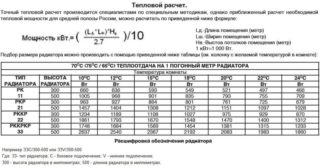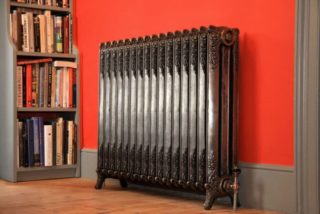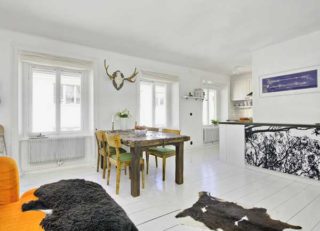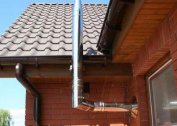To correctly determine the number of cast iron batteries installed in the house, you will need to familiarize yourself with the technical characteristics of these products. One of the most important indicators of their performance is the thermal power in kW in 1 section of a cast-iron radiator. With the known value of this parameter, finding the number of links required to heat a particular room is not particularly difficult.
Advantages of cast iron batteries
The advantages of cast iron batteries include the following properties:
- resistance to corrosion, not at all dangerous for cast iron;
- high rate of thermal inertness;
- reasonable price and the possibility of increasing the number of sections;
- durability of products.
When interacting with a coolant, the internal surfaces of cast iron are coated with a special coating of the “dry rust” type, which prevents corrosion. Features of the material and sufficient wall thickness allow the use of coolants of any quality in cast iron radiators. Cast iron practically does not wear out over time from the damaging effects of chemical impurities and aggressive media.
Cast iron batteries are attractive in that they have the ability to accumulate heat and then give it away when the heating is turned off or the temperature of the coolant is lowered. The advantages of cast iron products also include the ability to build or remove several working sections, ease of maintenance and installation.
Cast iron products, subject to regular care, can serve their owners for quite some time - at least 30-40 years.
The difference between imported batteries from domestic
Cast iron radiators, produced back in the days of the USSR, had a wide range of parameters and sizes. Regardless of this, the thermal power was approximately the same, which made it possible to install them in rooms of different sizes. Foreign cast-iron batteries have smaller dimensions with the same heat output.
When considering the cast iron material used in either case, there is a slight difference in the chemical composition and structure of the working surfaces. In domestic batteries, it is very rough, which creates a significant resistance to movement of the coolant and reduces the heat transfer performance. Foreign analogues have an absolutely smooth surface of the walls, guaranteeing unimpeded movement of fluid through the internal cavities. Therefore, imported devices allow a greater volume of heated water per unit time and give more thermal energy. As a result, the power indicator rises, which allows their use in rooms with a large area (up to 30 m2 or more).
Parameters of some battery samples
In the distant Soviet times, MC-140 batteries could be found in almost every apartment, and today they are perceived by many as a relic of the past. However, some users still prefer them to all other well-known models. Their fans usually choose the following two modifications:
- in the first model, the power of 1 section of a cast-iron radiator in kW is 0.120 units;
- for the second sample, this figure is 0.190 kilowatts.
The latter are much larger and much heavier - the height and width of the sections is 0.588 and 0.121 meters, respectively.The volume of internal cavities in one such segment is 1.5 liters.
Thermal efficiency of modern models
According to the thermal characteristics, modern samples of products based on cast iron are very diverse. Corresponding models from the Czech Republic have high rates of heating efficiency in residential spaces. Samples under the name Viadrus STYL 500 consist of sections, each of which allows you to develop a thermal power of about 0.14 kW. At the same time, its segments are almost twice lighter and smaller in size of most well-known domestic models.
The Viadrus STYL 500 battery section holds 0.8 liters of thermal media. Russian counterparts with approximately the same volume have slightly lower returns, corresponding to an indicator of 0.102 kW. They are slightly inferior to Czech products, but surpass MC-140.
Simple calculation
 For the simplest calculation of the thermal power of a battery, which requires rooms with an area of 25 m2, you need to calculate the volume of the room: 25 m2 multiplied by a height of 2.5 meters, it turns out 62.5 cubic meters. meter. The result of the calculations is multiplied by the specific power, the value of which is selected depending on the type of room. For a prefabricated house, it is equal to 0.041 kW per m3. At the final calculation, it turns out: 62.5x0.041 = 2.562 kW, which is an indicator of the total thermal power, which will be enough to heat an area of 25 m2.
For the simplest calculation of the thermal power of a battery, which requires rooms with an area of 25 m2, you need to calculate the volume of the room: 25 m2 multiplied by a height of 2.5 meters, it turns out 62.5 cubic meters. meter. The result of the calculations is multiplied by the specific power, the value of which is selected depending on the type of room. For a prefabricated house, it is equal to 0.041 kW per m3. At the final calculation, it turns out: 62.5x0.041 = 2.562 kW, which is an indicator of the total thermal power, which will be enough to heat an area of 25 m2.
According to a simple calculation formula, the calculation result is further divided by the power of one section: 2.562 / 0.14 kW = 18.3. This value is rounded to 19, the desired number of links in the battery is obtained. You will need to buy two batteries with 10 and 9 segments.
During the calculation, it should be remembered that the correction factor selected in it takes different values. For buildings rebuilt from brick, it is equal to 0.034 kW / meter. For modern block buildings, its value is 0.02 kW / meter. Based on the presented methods, it is possible to calculate the number of sections and solid batteries required for heating all rooms in a house or apartment.
Hard way
This method involves the use of two parameters at once: the total heat demand of the heated object and the heat output of one section of the radiator (this value is taken from technical references). When calculating the first of these indicators, the following factors are taken into account:
- area of the heated room;
- number of storeys of the building;
- ceiling height in the apartment;
- the presence in the house of air conditioning and a heating fireplace;
- number and total area of windows.
Also, the presence of insulation on the walls, on the floor and ceiling is taken into account.
The need for the amount of heat for the selected room is in the following sequence:
- Its volume is determined (the area is multiplied with height).
- The result is multiplied by 41 watts (according to the SNIP, such an amount of heat is needed for comfortable heating of one 1 cubic meter of living space).
- The result obtained is adjusted depending on the exact value of the ceiling height.
Depending on the location of the rooms and the height of the ceilings, the correction factors take the values of 0.8, 1.1 and 1.8. Based on them, the result obtained is divided by the specific heat transfer of the section and the required number of links is calculated.
Calculation specifics
Modern cast iron manufacturers offer their customers batteries with various operating parameters that define a wide range of specific capacities. Several methods are known for conducting technical calculations regarding the determination of the operational characteristics of radiators. Simple and more complex algorithms make it possible to find the necessary indicators with a given degree of accuracy (error) and, if necessary, correct them.
When introducing correction factors, many factors are taken into account, including the number of doors and windows in the room.When these structural elements are increased by at least one, in the general case, one section is added to the result. The same amendment must be introduced when taking into account the material from which the window or doorway is made.







